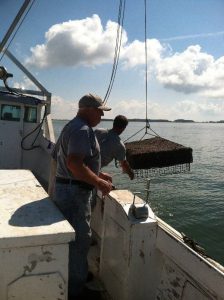
NCCOS scientist Suzanne Bricker spoke at the 2017 East Coast Commercial Fishermen’s and Aquaculture Trade Expo earlier this month. Collaborating with Maryland Sea Grant, the presentation highlighted the recently approved recommendations for crediting oyster tissue for nutrient removal as a Best Management Practice (BMP), with a focus toward ongoing research in support of the Oyster BMP Expert Panel’s continuing evaluation. Jurisdictions within the Chesapeake Bay watershed can now include harvested oyster tissue as a nutrient reduction BMP in their watershed implementation plans to fulfill required nutrient reductions. Studies have shown that 65 percent of U.S. estuaries, and all within the Chesapeake Bay region, are moderately to severely degraded by nutrient input.
Potential use of oysters as a nutrient BMP is of great interest, as there is already a thriving oyster industry in the Bay that could expand for nutrient reduction purposes in addition to provision of seafood. While there is presently no mechanism to pay oyster growers for the ecosystem service provided by their farms, the nutrient removed by harvested tissue can now be counted toward nutrient reduction goals. Development of a payment protocol within the larger nutrient credit trading program requires additional research and planning. However, growers who receive credits may see positive impacts now through marketing that can potentially generate higher prices or more sales depending on market or customer base.
For more information, visit NCCOS’s related project pages:
- Shellfish Aquaculture and Payment for Ecosystem Services in Chesapeake Bay http://coastalscience.noaa.gov/projects/detail?key=250
- National Estuarine Eutrophication Assessment Update http://coastalscience.noaa.gov/projects/detail?key=249
- Eutrophication and Oyster Aquaculture in the Patuxent River http://coastalscience.noaa.gov/projects/detail?key=251
- AquaSpace – An Ecosystem Approach to Making Space for Sustainable Aquaculture http://coastalscience.noaa.gov/projects/detail?key=252
- Planning for Sustainable Shellfish Aquaculture in Complex Multiple Use Environments: Determining Social and Ecological Carrying Capacity for South Puget Sound (PECSA) http://coastalscience.noaa.gov/projects/detail?key=248
- Aquaculture and Eutrophication in Long Island Sound and Great Bay – Piscataqua Estuary http://coastalscience.noaa.gov/projects/detail?key=32
Try the models yourself at: www.eutro.org/register (Assessment of Estuarine Trophic Status[ASSETS] eutrophication model); www.farmscale.org (Farm Aquaculture ResourceManagement [FARM] shellfish aquaculture model)
